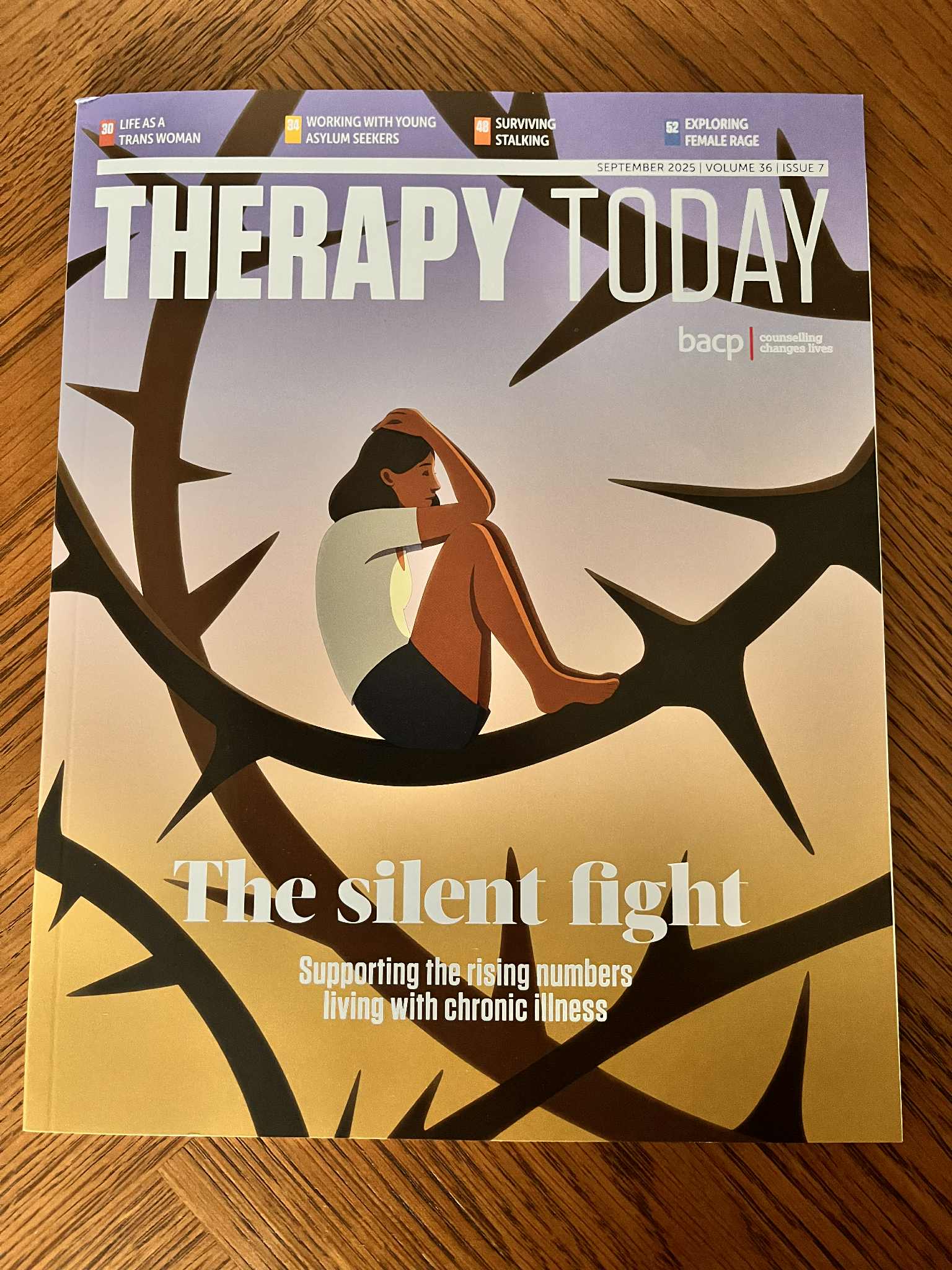News from BACP:
Our response to Department of Health and Social Care consultation on men’s health strategy
We’ve called for mental health services to better meet the specific needs of men and boys in our response to a Government call for evidence.
Although our 2025 Public Perceptions Survey showed that more men are likely to go for therapy now than they were 15 years ago – they’re still more likely than women to think there’s a stigma attached (47% of men, compared to 38% of women).
Not meeting needs of men and boys:
In our submission to the Department of Health and Social Care’s consultation we’ve said that services are often ‘feminised’ in design, which can contribute to low uptake by men. Men are also considerably underrepresented in the psychological professions, including counselling and psychotherapy, which furthers the impression that these services are not suited to the needs of men and boys.
We’ve also highlighted how internalised gender biases, harmful stereotypes and a failure to address barriers and increased risks for some groups, are also preventing some men from reaching out for support.
We pointed to our R.A.I.S.E. campaign, standing for Risk-taking, Anger, Isolation, Substance abuse, and Exhaustion, in which we encouraged people to look for and identify the signs of depression in the men in their lives – and encourage them to seek help.
Factors affecting men’s mental health:
Our response also included evidence and factors that affect men’s mental health and wellbeing, including socioeconomic elements; gender norms, social pressures and masculinity; and life milestones.
Martin Bell, our Head of Policy and Public Affairs, said: “Our evidence shows that men and boys experience mental distress differently and are exposed to different risk factors compared to women and girls.
“Evidence shows men tend to engage only at crisis points, not during early, preventable phases of distress. If showing emotional vulnerability and asking for help were destigmatised, this could make accessing support more socially acceptable for men and prevent unnecessary suffering.
“While it’s encouraging that more men are accessing support, we’re concerned that a larger proportion still feel unable to do so , and an increase in help-seeking may disguise a significant rise in mental distress among men and boys.
“We believe that having more men working in mental health professions, along with commissioning, designing, delivering and evaluating services in partnership with men and boys with lived experience of poor mental health – would help normalise and encourage men to talk openly about their mental health. It’s vital that mental health services understand men and boys’ needs can be different.”
Number of improvements to service needed:
We’ve called for the government to make a number of improvements to services to better meet the needs of men and boys. This includes incorporating physical activity-based support into services and carrying out local outreach through community organisations and charities which can better engage racialised men. Evidence shows that racialised men and boys often have their distress pathologised, leading to worse health outcomes, including disproportionate rates of detention under the Mental Health Act.
We’ve also highlighted the need for tailored suicide prevention strategy that consider masculine norms, and to develop targeted provision for racialised men and boys. We’ve said the third sector services who often deliver this work need longer-term and more sustainable funding.
Our key recommendations for the strategy are:
- Encourage greater male representation in mental health professions, including counselling and psychotherapy
- Commission, design, deliver and evaluate services in partnership with men and boys with lived experience of poor mental health
- Explore and tackle implicit biases that may prevent men from being referred to the right support
- Support initiatives which build community through a common activity or interest while creating a comfortable space to discuss concerns
- Use a public health approach to tackle drivers of physical ill-health which, in turn, increase the risk of mental illness
- Implement a cross-department approach to tackle intersecting challenges such as unemployment, homelessness, and substance misuse, all of which contribute to worsening mental health
- Address regional inequalities (the “postcode lottery” for mental health support) and invest further in services in underserved areas, such as rural and coastal communities
- Support regeneration programmes in economically-deprived regions, recognising the link between deprivation and poor physical and mental health outcomes
Summary of key recommendations:
- Encourage greater male representation in mental health professions, including counselling and psychotherapy
- Commission, design, deliver and evaluate services in partnership with men and boys with lived experience of poor mental health
- Explore and tackle implicit biases that may prevent men from being referred to the right support
- Support initiatives which build community through a common activity or interest while creating a comfortable space to discuss concerns
- Utilise a public health approach to tackle drivers of physical ill-health which, in turn, increase the risk of mental illness
- Implement a cross-department approach to tackle intersecting challenges such as unemployment, homelessness, and substance misuse, all of which contribute to worsening mental health
- Address regional inequalities (the “postcode lottery” for mental health support) and invest further in services in underserved areas, such as rural and coastal communities
- Support regeneration programmes in economically deprived regions, recognising the link between deprivation and poor physical and mental health outcomes
Factors driving behaviours posing a risk to health among men and boys
Socioeconomic factors:
Satisfying employment is an influential factor in determining men’s mental health and wellbeing. Men with high job satisfaction are more likely to report feeling optimistic, happy, motivated, emotionally stable, in control and confident.1 Meanwhile, unemployment, redundancy, and economic precarity disproportionately affect men’s health due to traditional gender roles linking male identity with expectations of being the primary earner in the household. These factors contribute in turn to depression, substance misuse, and suicide.2
1Barry & Daubney, 2017
2 Affleck et al., 2018; Whitely 2019
Men are disproportionately affected by homelessness and poor-quality housing, both linked to higher rates of cardiovascular, respiratory, and mental illness.3 Men are far more likely to be rough sleepers than women and often lack the social support networks to secure safe shelter. Homelessness, rough sleeping and other forms of insecure housing are predictors for worse mental health outcomes and an increased risk of suicide.4
Geographic disparities, often together with wider economic inequalities, are a significant driver of poor health in men. Men in disadvantaged and rural areas are at greater risk of dying from conditions that could have been prevented.5 Our member, Anthony Davis, spoke to the Health and Social Care Committee in 2023 of the “postcode lottery” for effective mental health care and its impact on men and boys. We welcome proposals in the 10-Year Health Plan to reallocate funding to GPs and primary care services in more economically deprived areas.
Gender norms, social pressures and masculinity:
Traditional masculine norms such as emotional suppression, self-reliance, and stubbornness are key behavioural drivers that inhibit help-seeking and contribute to delayed or avoided intervention.6 They can also contribute to unhealthy coping mechanisms like substance misuse.7 However, reframing traits such as emotional vulnerability as signs of strength can de-stigmatise help-seeking and support self-worth.
Adherence to “masculine ideologies” has been linked to heightened suicide risk.8 Mental health stigma also plays a critical role, where emotional vulnerability is perceived as weakness, which discourages early intervention,9 especially for men and boys of colour.10 The growth of the “manosphere”, particularly among boys and young men, holds them to rigid gender expectations which do not allow for emotionality, shows of vulnerability or help- seeking.
Going further, this movement is part of a wider context of gender polarisation11 which alienates men and boys from women and girls, lending to feelings of shame, isolation, and rejection. The “manosphere” promotes unhealthy ideals of masculinity and femininity and promotes an oppositional picture of gender relations, rather than encouraging community, friendship and mutual respect. Rejection, or perceived rejection, by women and girls is characterised by this online movement as a threat to one’s masculinity, rather than something normal that everyone will go through.12 This tells boys and young men that their
3 Ramsay & Bunn, 2023
4 Nilsson et al., 2025
5 Ramsay & Bunn, 2023
6 Affleck et al., 2018; Eggenberger et al., 2024; Shepherd et al., 2023; Whitely 2019 7 Shepherd et al., 2023
8 Eggenberger et al., 2024 9 Shepherd et al., 2023
10 Brown, 2023
11 Campbell et al., 2024
12 Sparks et al., 2022
Value is determined by their perceived attractiveness to the opposite sex, rather than something inherent within them.
13 Evidence shows men tend to engage only at crisis points, not during early, preventable phases of distress.14 If showing emotional vulnerability and asking for help were framed as signs of strength and healthy masculinity, this may make accessing support more socially acceptable for men and prevent unnecessary suffering. Self-compassion has also been found to have a moderating or “buffering” effect on self-stigma for men seeking help with their mental health.15
“An important source of intervention is normalising and being able to encourage men to talk about their mental health in the workplace, particularly workplaces and environments that foster a lot of stress, such as construction, farming, the financial industry and where men are travelling for long periods of time on the road. Those are the ones who usually come from some of the lower economic backgrounds. The ones who are the main financial providers, come from working-class backgrounds, and do not normally seek help for their mental or physical health. Enabling them in their work environments to talk about their mental and physical health—the two are linked— would be quite useful.” – Anthony Davis MBACP, 2023, Oral Evidence to the Health and Social Care Committee16
Life Milestones:
Life transitions such as fatherhood, divorce, and separation are also risk factors for men’s mental health. Divorce and the loss of child custody, in particular, contribute to social isolation and worsening mental health outcomes.17 After a family breakdown, men are less likely to have access to other social support networks to rely on for community, belonging, and comfort.18 When they do, they may have unhealthy standards of stoicism and emotional suppression reinforced by their peers.
Older men are more prone to loneliness, especially after retirement or bereavement, which has strong links to depression and increased mortality.19 Retirement is a significant life transition which may lead to a sense of identity loss and greater psychological distress.20 Older people may find it particularly challenging to break from traditional gender roles even when they cause them significant harm.
13 Ofcom, 2025
14 Shepherd et al., 2023
15 Heath et al., 2017
16 Health and Social Care Committee, 2023 17 Whitely, 2019
18 Scourfield & Evans, 2015
19 Ramsay & Bunn, 2023
20 Vo et al., 2015
Suggestions for improving health outcomes for men and boys
Service access, design and delivery:
- Encourage greater male representation in mental health professions, including counselling and psychotherapy
- Commission, design, deliver and evaluate services in partnership with men and boys with lived experience of poor mental health
- Explore and tackle implicit biases that may prevent men from being referred to the right support
- Support initiatives which build community through a common activity or interest while creating a comfortable space to discuss concerns
We welcome news that the approach of the Women’s Health Strategy will be mirrored by developing a Men’s Health Strategy that addresses inequalities over the life course, as recommended in recent research.21 Our evidence shows that men and boys experience mental distress differently and are exposed to different risk factors compared to women and girls. Despite this, mental health support services are perceived as “feminised” or feminine and ill-suited to support men and boys, with 56% of therapists agreeing that men are less likely to get mental health support than women according to a 2023 BACP survey.22 Men are also underrepresented among counsellors, psychotherapists, and in the psychological workforce,23 furthering the impression that mental health support is something provided by, and for, women.
The number of men seeking support appears to be growing. A 2023 BACP survey of more than 3,000 of our members found that 52% of therapists reported an increase in men presenting with depression over the past year. While it is encouraging that more men are accessing support, we are concerned that a much larger proportion feel unable to do so, and an increase in help-seeking may disguise a significant rise in mental distress among men and boys.
Health practitioners may also reinforce bias due to their own internalised gender expectations. Women and girls are almost twice as likely to be referred to NHS talking therapies compared to men and boys.24 Given the evidence shared in this submission concerning the harmful stereotypes which prevent male help-seeking, this paints a worrying picture where men and boys contend with additional barriers to ask for support to be denied access regardless.
Public health approaches:
21 Fenney & Raleigh, 2024
22 BACP, 2023a
23 BACP, 2023; Morison et al., 2014 24 Rzepnicka et al., 2022
• Utilise a public health approach to tackle drivers of physical ill-health which, in turn, increase the risk of mental illness
Efforts to develop tailored mental health support pathways should be complemented by a public health approach to tackle the holistic drivers of mental distress in men and boys. Evidence shows that reinvesting in public health budgets and focusing on upstream prevention (e.g., smoking and obesity regulation) is more effective than relying on individual behaviour change alone.25
Socioeconomic challenges:
- Implement a cross-department approach to tackle intersecting challenges such as unemployment, homelessness, and substance misuse, all of which contribute to worsening mental health
- Address regional inequalities (the “postcode lottery” for mental health support) and invest further in services in underserved areas, such as rural and coastal communities
- Support regeneration programmes in economically deprived regions, recognising the link between deprivation and poor physical and mental health outcomes
Deaths of despair (for example, from substance misuse and suicide) are especially high among men in deprived areas and five times higher than in the least deprived areas.26 Addressing the social determinants that drive these outcomes—such as poverty, housing insecurity, and unemployment is essential. Counsellors and psychotherapists can play a meaningful role in helping men to cope with the pressures of these factors, build life satisfaction and access meaningful employment, however this must be supported by a cross- departmental government approach which resolves the underlying socioeconomic challenges.
Economic regeneration in deprived communities, especially in the North of England and rural communities, would reduce structural drivers of poor health and promote economic and health resilience.27 We were pleased to hear of proposals as part of the 10-Year Health Plan to boost rural and coastal health and believe that will be one avenue of many through which to tackle poor mental health in men and boys.
Views on whether current services are meeting men’s needs/Men’s access, engagement and experience of the health service:
Mental health services are not currently meeting the specific needs of men. There is limited provision tailored to the male experience of distress. Mental health services remain feminised
25 Fenney & Raleigh, 2024
26 Fenney & Raleigh, 2024 27 Fenney & Raleigh, 2024
In design, contributing to low service uptake by men.28 Going further, men are underrepresented in the mental health workforce. To men and boys seeking help, this creates the perception of a service not suited to, nor understanding of, their experience. Diagnostic criteria for conditions including depression and anxiety may reflect a more female experience and thus exclude or undervalue symptoms of distress more common in men, including anger and substance misuse.
Black men face additional barriers to support within mental health services. Standardised mental health assessments often focus on pathology and risk (e.g., “What is wrong with you?”) rather than trauma-informed approaches (e.g., “What happened to you?”), which are more aligned with the lived experiences of Black men whose distress is often linked to systemic and racial trauma.29 Pathologisation, racism and institutional bias reduce engagement with NHS services30 and wider support structures. Reforms to the Mental Health Act 1983 seek to tackle racial disparities in treatment, however it remains to be seen whether these shall be fully effective. Going further, existing harms already dealt by racial inequalities will need to be redressed, and trust in the NHS and wider services will need to be rebuilt.
Gay, bisexual, and transgender men face increased risks for poor mental health, substance use, and certain illnesses, often due to stigma and inadequate support.31 The wider climate of political hostility towards transgender people, discrimination and harassment has cultivated a rise in poor mental health in that community.32
Suggestions for how services can be improved to better meet men’s needs:
Mental health services should incorporate action-oriented interventions. Men are more likely to engage with physical activity-based support (e.g., Men’s Sheds) than traditional talking therapies alone.33 Local outreach through community organisations and charities (e.g., Orchid) is also effective in reaching underserved and racialised men, particularly through peer-led education and early intervention models.34
Tailoring suicide prevention strategies by considering masculine norms may also increase effectiveness.35 One approach to achieve this may be to develop gender-sensitive health messaging that acknowledges positive masculine values while promoting mental health. Similarly, in the context of counselling services, Shepherd et al.36 suggest a need for male- specific health promotion that resonates with men’s identities rather than challenges them.
28 Affleck et al., 2018; Whitely 2019
29 Brown, 2023
30 Brown, 2023
31 Ramsay & Bunn, 2023; Jaspal et al., 2023
32 Marzetti et al., 2024; Connolly et al., 2025 33 Whitely, 2019
34 Fenney & Raleigh, 2024
35 Eggenberger et al., 2024
36 Shepherd et al., 2023
Our R.A.I.S.E. campaign draws attention to the specific signs of depression in men and boys through its apronym, standing for Risk-taking, Anger, Isolation, Substance abuse and Exhaustion.
Whitely proposes education and job training reform to address NEET (Not in Employment, Education, or Training) rates among young men.37 Such reforms help reduce disengagement and associated long-term health risks. Homelessness and housing security are also significant challenges linked to worse health outcomes. Often, homelessness is a consequence, not simply a cause, of mental distress in men. Third sector support, housing associations, and other specialised services can prevent men and boys from falling into homelessness and provide them with the tools to improve their living circumstances. Counselling and psychotherapy can be embedded into these vital services to tackle the socioeconomic factors leading to poverty, housing insecurity and long-term unemployment.
Targeted provision for racialised men and boys can more accurately reflect their experience, to avoid repeating the racial harm and disparities inflicted on them by the health service and indeed, wider society. Community-based models, such as training peer champions and embedding services within trusted local organisations, are particularly successful with hard- to-reach men, including racialised groups.38 This is often delivered by third sector organisations whose work is highly reliant on short-term funding awards, thus hampering the long-term provision of these services. We recommend that integrated care board (ICB) funding cycles are extended from three to five years to better facilitate the staffing and delivery of this specialist support offer.
Gaps in data or evidence:
There are significant diagnostic gaps related to how male depression is identified and understood. Common symptom measures do not account for gendered expression of mental health issues, leading to male underdiagnosis and under-treatment.39 Our R.A.I.S.E. campaign mentioned above aims to highlight gender differences in the presentation of depression in men.
There is insufficient data disaggregated by gender and race in many key health indicators, making it harder to fully understand or respond to the needs of subgroups such as Black men and older GBTQ men.40
Depression in men often presents as ‘masked’ or externalising behaviours such as aggression, substance misuse, and irritability, leading to underdiagnosis and misinterpretation.41 This contributes to inaccurate prevalence rates and treatment gaps.
There is a structural and cultural under-recognition of men’s health needs, reflected in policy bias, underfunding, and limited service provision. Men’s issues remain underrepresented in key gender and mental health reports.42
37 Whitely, 2019
38 Fenney & Raleigh, 2024
39 Affleck et al., 2018; Whitely 2019
40 Brown, 2023; Fenney & Raleigh, 2024 41 Affleck et al., 2018; Whitely 2019
References
Affleck, W., Carmichael, V., & Whitley, R. (2018). Men’s Mental Health: Social Determinants and Implications for Services. The Canadian Journal of Psychiatry, 63(9), 581–589. Available at: https://doi.org/10.1177/0706743718762388
Barry, J., & Daubney, M. (2017). The Harry’s masculinity report. Male Psychology Network.
BACP. (2023). Workforce Mapping report October 2022 to September 2023.
BACP. (2023a). Men’s mental health and access to therapy highlighted in Parliament. Available at: https://www.bacp.co.uk/news/news-from-bacp/2023/6-december-men-s- mental-health-and-access-to-therapy-highlighted-in-parliament/
Brown, C. (2023). Black men, mental health & the national health service. Psychodynamic Practice, 29(3), 259–270. Available at: https://www.tandfonline.com/doi/full/10.1080/14753634.2023.2203412
Campbell, R., May, G., Duffy, B., Skinner, G., Gottfried, G., & Hewlett, K. (2024). Emerging tensions? How younger generations are dividing on masculinity and gender equality. Available at: https://kclpure.kcl.ac.uk/portal/files/247651437/emerging-tensions.pdf
Connolly, D. J., Meads, C., Wurm, A., Brown, C., Bayliss, J., Oakes-Monger, T. C., & Berner, A. M. (2025). Transphobia in the United Kingdom: a public health crisis. International journal for equity in health, 24(1), 155.
Eggenberger, L., Spangenberg, L., Genuchi, M. C., & Walther, A. (2024). Men’s Suicidal Thoughts and Behaviors and Conformity to Masculine Norms: A Person-Centered, Latent Profile Approach. Heliyon, 10(20), e39094. Available at: https://doi.org/10.1016/j.heliyon.2024.e39094
Fenney, D., & Raleigh, V. (2024, June 12). Inequalities in men’s health: Why are they not being addressed? The Kings Fund. Available at: https://www.kingsfund.org.uk/insight-and- analysis/blogs/inequalities-mens-health-why-are-they-not-being-addressed
Health and Social Care Committee. (2023). 5 December 2023 – Men’s health – Oral evidence. Available at: https://committees.parliament.uk/event/19959/formal-meeting-oral- evidence-session/
Heath, P. J., Brenner, R. E., Vogel, D. L., Lannin, D. G., & Strass, H. A. (2017). Masculinity and barriers to seeking counseling: The buffering role of self-compassion. Journal of counseling psychology, 64(1), 94.
Jaspal, R., Lopes, B., & Breakwell, G. M. (2023). Minority stressors, protective factors and mental health outcomes in lesbian, gay and bisexual people in the UK. Current Psychology, 42(28), 24918-24934.





